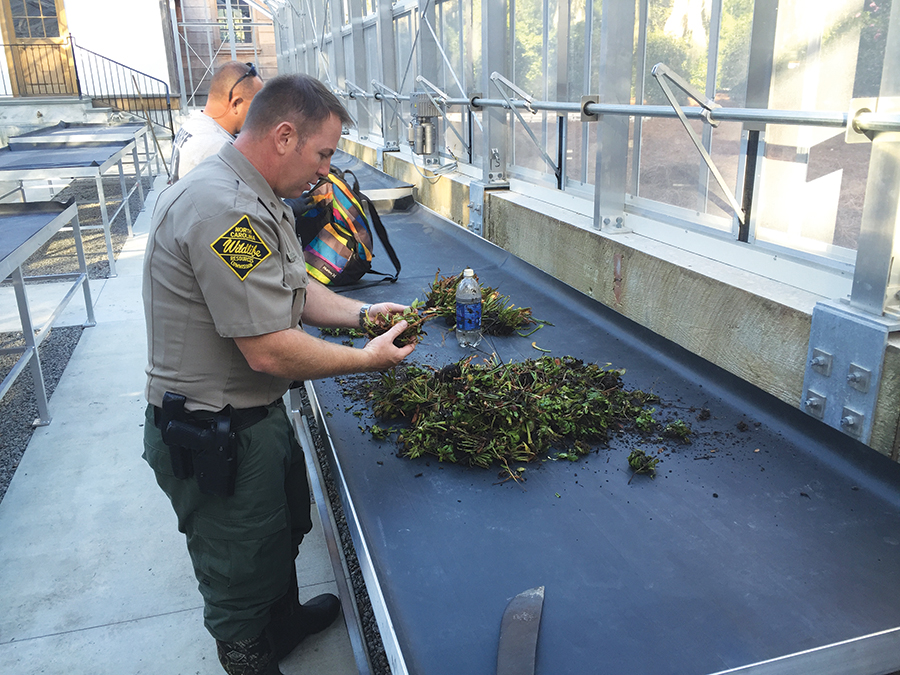A tight-knit group of Venus flytrap poachers find easy targets in local game lands, gardens and nurseries
By Kevin Maurer
North Carolina Wildlife Officer T.C. Stacy flipped on his police lights when he spotted the muddy car exiting the Pinch Gut game lands between U.S. 17 and N.C. 211 in Brunswick County. It was a Saturday, and he’d been teaching a hunting safety class in Harnett County with Master Officer J.D. White when they got a picture of a poacher making his way across the game land from one of their motion-activated game cameras. The camera was part of a monthlong investigation last year into flytrap poaching from Pinch Gut.
Stacy and White pulled up behind the car with their lights flashing. The driver pulled over to the side of the road. When Stacy got to the driver’s side window, he found Archie Lee Williams Jr., 41, of Bolivia. Williams’ clothes were covered in dirt. His hands were filthy. Stacy noticed thick grime under his fingernails.
“Were you hunting?” Stacy said, peering into the car.
“No,” Williams said.
“You out drinking beer or running dogs?”
Williams wasn’t doing either. “You know what I was doing,” he said.
Stacy did. Williams was a flytrap poacher, one of many who live and work near the game land in Brunswick County. It’s a crime that you can only find within 75 miles of Wilmington, where flytraps are indigenous. Poachers traffic in thousands of flytrap plants yanked illegally from public game lands, as well as from gardens and stolen from nurseries.
“Do you mind if I look in the vehicle?” Stacy asked.
Williams told him he could. In the back seat, Stacy found a book bag filled with flytraps: 216 plants in all. A pair of scissors and a digging tool were also shoved into the bag.
“Do you mind showing me where you got them?” Stacy said.
Williams took Stacy and White back into the Pinch Gut game lands and showed the wildlife officers where he had dug out the plants. Stacy took photos of the site and then arrested Williams, who faced 73 felony counts of taking a Venus flytrap. He was booked in jail under a $750,000 bond.
Later, when they questioned him, Williams admitted to poaching the Venus flytraps once a week, rotating between various game lands across the county. He sells them to a guy — Williams only told the officers the first name — who pays $25 for 100 plants. During the questioning, Williams also told Stacy he was going to eat the plants. “Yeah,” Stacy said. “How do you cook them?”
Williams just rolled his eyes.
In August, Williams pleaded guilty to nine counts of felony for the taking of a Venus flytrap and was sentenced to 60 days in custody, a threshold he met while awaiting trial. His plea agreement was the result of his cooperation with law enforcement, evaluation of having a diminished mental capacity, and his efforts to mitigate wildlife loss caused by his actions by replanting the stolen plants.
Williams’ case was one of the first few to be charged under the new law, which changed poaching from a misdemeanor to the same felony classification as possessing and distributing heroin. “Mr. Williams could have easily gone to prison for 700 months. I don’t think that is what the legislature intended,” Brunswick County Assistant District Attorney Chris Thomas says. “But there needs to be a civic consequence. This is an irreplaceable resource. Once it’s gone, it’s gone.”
Williams did not respond to requests for an interview. His lawyer, Ryan Smithwick, says his client had limited mental ability after suffering from a traumatic brain injury. He was out of work and had no means. “He just picked up a whole bunch of plants,” Ryan Smithwick says. “He didn’t hurt anyone.”
Crime Ring
Flytraps use nectar to lure insects — not flies per se, but the ones that crawl into its jawlike leaves. The insect brushes up against the trigger hairs that look like eyelashes around the border of the leaf and trigger the trap. The leaves close, and enzymes dissolve the insect. The insects are a supplement in the nutrient-starved soil.
The plant’s scientific name, Dionaea muscipula, is derived from words meaning “the goddess of love” and “mousetrap.” With its bright red center and spiky edges, the plant has long captured not only its prey, but the human imagination. In 1760, North Carolina Colonial Gov. Arthur Dobbs said of the the flytrap: “The greatest wonder of the vegetable kingdom is a very curious unknown species.” Charles Darwin described it as “one of the most wonderful plants in the world.”
Stephanie Wert Borrett, director of donor relations for the Coastal Land Trust, grew up in Texas and remembers flytraps being in her science books. The Land Trust maintains the Stanley Rehder Carnivorous Plant Garden off Canterbury Road in Wilmington. “Flytraps blew Charles Darwin away,” she says. “They don’t grow in the wild anywhere, and they are all genetically traced back to here.” The Venus flytrap was declared the state’s official carnivorous plant in 2005. The Nature Conservancy estimates that 35,000 of them remain.
Jessica Roach, a graduate student at UNCW who studied flytraps and worked to conserve them in Carolina Beach, thinks the attraction to the plant comes from how easy they are to personify. They consume bugs or “eat” like humans, she says.
So why are poachers stealing the plant?
The actual reason remains a mystery. Some believe the flytraps are being poached for supplements that promise to increase libido or help the body heal.
“It may be like a rhino horn,” says John Taggart, an associate professor emeritus in UNCW’s Department of Environmental Studies. A supplement company called Carnivora sells liquid drops and capsules of flytrap extract. The company’s website says its products promote antioxidants and support “resistance to harmful invaders.”
The demand for flytraps — either to make supplements or for house plants — has led to what the true crime podcast “Criminal” has called “a Venus flytrap crime ring.”
“We don’t know where they are going,” Roach says. “It’s really a closed ring and really tight-knit. It’s very secretive.”
Poaching spikes from late May to mid-June. Wildlife officers estimate about 200 flytraps are poached from game lands every week. Thomas, the district attorney who prosecuted the Williams case, wasn’t sure where the poached plants ended up. He says most of the plants online were not indigenous, but clones. China and Amsterdam have large flytrap-cloning operations.
Most of the poachers are poor, rural African-Americans, according to Taggart and law enforcement officials. Thomas says several families were suspected of being in the poaching business. “They need the money,” Taggart says. “They take them and sell them on the black market.”
Stacy says it will be quiet for months and then one day he’ll get several reports at once. “It’s organized,” he says.
Smithwick, Williams’ lawyer, refused to provide details about the fly-poaching ring or name Williams’ contact, only saying his client was two or three links between getting the plant and its end use. “Archie has been doing it since he was a kid,” Smithwick said. “Local folks have done it forever. Mr. Williams can’t hold down a job. He is terribly disabled. A lot of memory loss. It was a way for him to make some money.” Williams has been in the justice system since 1993 and charged with myriad misdemeanors and felonies, ranging from drug possession to assault and shoplifting.
But flytrap poachers do not only hit the game lands. Fly-Trap Farm, near Supply, N.C., about 25 miles southwest of Wilmington, was burglarized in September 2013. The thieves took more than 18,000 flytraps, estimated to be worth $65,000, according to local media reports. Flytraps grow in clusters, so a poacher can get anywhere from 50 to 100 plants at a time and sell them at flea markets or to nurseries. It’s free money and for a long time was just a misdemeanor.
That all changed in 2014 when North Carolina — spearheaded by New Hanover County Rep. Ted Davis — changed the poaching of flytraps from a misdemeanor and a maximum fine of $50 to a felony. Poachers now face 29 months in prison for stealing each plant.
The first felony arrests occurred in 2015, when four men were caught with 970 Venus flytraps. Williams is the third felony case since the law changed. “They come in on game land and try and make a quick buck and bounce out of there,” Stacy says. “They risk a felony for $20. It’s hot. Spiders. Snakes. You’re in the middle of nowhere. It’s hard work. You’ve got to know what you’re looking for.”
The State Trooper of the Woods
It’s a Saturday in October and Officer Stacy is on patrol. We meet at a McDonald’s in Brunswick County and immediately head to Holden Beach, where he has to deal with cars blocking a public boat launch. Threatening to tow NC Festival by the Sea attendees’ cars is not why Stacy gave up a good-paying job in the nuclear industry to become a wildlife officer.
Stacy wanted to be a game warden from the first time he spotted one stepping out of his patrol car when he was 9 years old. Stacy was with his father hunting, and the game warden stopped to check his father’s hunting license. The man’s uniform was pressed and sharp, his green pants with a black line down the leg impeccable. When the game warden left, young Stacy looked up at his father and asked who that was.
“That’s the state trooper of the woods,” his father said.
Stacy wanted to be that. After high school, he got a job working at the Brunswick Nuclear Power Station as a mechanic. The job paid well, but his wife had to physically eject him from bed to go to work. While he turned wrenches at the plant, he applied for a spot in the Wildlife Commission. With only 220 officers statewide, the spot is competitive. It took a couple of rounds; each time he failed to get a slot, he bird-dogged the state website waiting for the next job announcement, and each time he was the first applicant. When he finally got the job, he attacked it. After a year of training in the law enforcement academy and in the field, Stacy got posted in Columbus County.
After clearing out the launch, Stacy drives back up U.S. 17 to patrol the Green Swamp Preserve. He speaks with a rural North Carolina accent. He has a slight build and short cropped brown hair. As he talks about his job and the Williams case, the passion can’t be contained in the cab of his truck. This isn’t a job to Stacy. This is his life. He is on patrol 24/7, even when he is home.
Wildlife officers work from home and set their own hours. As he drives to the game land, he talks about past cases. During one case, he couldn’t find a hide for some duck hunters who were taking more than their daily limit. Then one night, he woke up and asked his wife to hand him his phone. He’d been driving in the area that day looking for any path to the site when it struck him. He got on Google maps and finally found the dirt road leading to the hunters.
He issued the citations soon after.
Stacy gets off the paved road and follows a dirt track into the pine forest and tangled brush. He spends the next couple of hours checking hunting licenses and making sure the deer are properly tagged. Stacy is by the book. Fair to everyone. No rules are bent. He has even issued citations to friends of the family and in-laws in the past.
“I don’t like killing anything,” Stacy tells some hunters after checking their deer license. “If you can make it quick and painless, be respectful of the game and other hunters.” When a hunter agrees to take a dead deer from the game land, Stacy makes a point to tell the man that “went a long way with him” as he hands him a ticket for not registering a separate kill.
After checking the hunters, he heads over to an area where flytraps are prevalent. The area is deep in the game land, isolated from the main road. As he drives slowly down the dirt track, he spots a half-empty Gatorade bottle sitting on a berm. A marker or litter?
“That raises the hairs,” Stacy says, stopping nearby.
Putting on an orange baseball hat because its hunting season, he trudges through the brush following a path near the Gatorade bottle. “Maybe this is just a deer path,” he says. “Or maybe not.” Finding the plants is difficult. Digging them up isn’t easy. This isn’t a crime committed by amateurs. Locations and techniques are passed down, Stacy says. Some poachers have special diggers made out of swing set pipes crushed flat into a shovel so they can slide the flat spade into the dirt and pop the plants up.
About 20 yards from the dirt track, Stacy stops and starts poking in the underbrush. It’s thick and twisted. Gullies run through the sandy soil on the pine forest’s floor. The search is slow and meticulous. Each step measured for fear of stepping on a patch of flytraps. The plants like space, but not too much space. They like water, but not too much. Same with sunlight. They need fire to thrive — which is why controlled burns are so important.
“They are a real finicky plant,” Stacy says.
After walking back about 40 yards from the road, Stacy spots a patch under some brush in a gulley. He pulls back the tangle of brown, and it’s replaced by a patch of bright green. The flytrap is small with a bulbous green head and a deep red mouth. The plant’s mouth is gaping open like it just witnesses something amazing. It’s mouth is open so wide, you half expect to hear the plant gasp.
Once you spot one plant, you start to see them all over. There is something amazing about seeing the flytrap up close in the wild. Their beauty sticks out, but deep down it is their exotic nature.
Let’s be honest. A carnivorous plant shouldn’t grow in a pine forest a short drive from Wilmington. They belong in the deepest, darkest depths of the Amazon, where they grow so big they could eat people.
But no. This little wonder grows in our backyard. And it’s ours to marvel at and, more importantly, protect. Walking back to the truck, Stacy makes sure he grabs the Gatorade bottle.
“What you think you’re going to find, you’re not going to find,” Stacy says as he tosses the Gatorade bottle into the back of the truck. “We could spend all day looking and not find them. (Poaching) is a lot of work for not a lot of return.”
Kevin Maurer is the author of nine books, including No Easy Day: The Firsthand Account of the Mission That Killed Osama Bin Laden. He lives in Wilmington.



